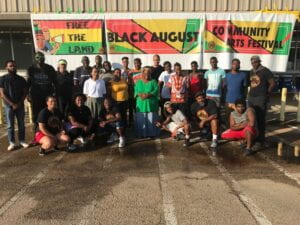
I have spent the past few weeks working on case studies to address this research question. “How do low-income/working-class communities of color win, implement, and defend meaningful policy changes at the local level?”
As soon as I read this question, I revisit the book Jackson Rising, which focuses on Cooperation Jackson and their work in Jackson, Mississippi, to gain a deeper understanding. I am focusing on how Cooperation Jackson defends their land against West Jackson’s massive gentrification. It was incredibly challenging due to the predominance of the Black working class in that area, while at the same time, the area was experiencing white flight-induced capital flight for 30+ years. Since the 1970s, it has become a Black working-class community with high poverty concentrations. There are currently more than 1,832 vacant lots and 832 abandoned structures in the community out of 6,748 vacant lots. The vast majority of the estimated 13,890 people in the community are Black.
Significant speculative pressures develop due to major development initiatives, such as the Medical Corridor initiative, which, with the assistance of state relief funds, has led to huge capitalization that provides the economic conditions that enable and drive other economic developments. This initiative creates massive construction jobs and housing for the incoming doctors, nurses, and other healthcare workers who need to live close to the Medical Corridor arena, as well as places to dine, shop and worship. Unsurprisingly, the area’s Black working class is not included in planning the new town’s massive development initiatives. Cooperation Jackson, recognizing this issue, decided to construct the fortification line, a line at which they inform developers that they cannot pass. Through their mutual aid networks and community land trust, they could acquire enough land surrounding this development area. Cooperation Jackson will not sell or consent to a developer who approaches them to ensure that gentrification does not occur.
Cooperation Jackson is not the only case study I am researching at the moment; another focuses on the feminine power organizing of the interfaith NGO HAKI in Ferguson, Missouri. Police misconduct and violence in the City cannot be resolved through a power-masculine approach and should be refocused via a more feminine approach. HAKI is a multireligious community led by Latina immigrants and staffed by Black, Latina, and Jewish community members. During the 2014 murder of Michael Brown in Ferguson, they concluded that police misconduct must change and transformation must start happening. Changes are beginning to materialize as a result of police officers and HAKI activists working together and establishing personal relationships.
I cannot speak in great detail about HAKI because I have only recently begun researching this topic briefly this week. Nonetheless, the most important thing I have learned from these case studies is why Right to the City specifically assigned me this task. I have realized from both historical context and current struggles that Right to the City is a movement that strives to improve its organizing strategies continuously. It must understand the meaning and methods of achieving, defending, and implementing policies. As we have seen in Jackson and Ferguson, cases of discrimination by increasing police violence and massive gentrification in the urban arena necessitate organizations like Right to the City that can push to give the City back to the people who deserve it in a space that is inclusive to all, that does not continuously evict its own residents, and that does not inflict violence on its people because of their skin color.
Sources:
Akuno, Kali, and Ajamu Nangwayam. Jackson Rising: The Struggle for Economic Democracy and Black Self-Determination in Jackson Mississippi. Daraja Press, 2017
Shields, Alexandra Pineros. “Midwife for Power: Towards a Mujerista/Womanist Model of Community Organizing.” UTS ePress, 14(2), December 2021.


Leave a Reply